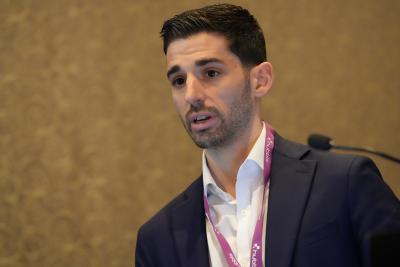Hatheway’s Way: New Portfolio Paradigms for a Post-Peak World

Larry Hatheway of GAM Investments
May 4, 2019
Larry Hatheway, Group Head of GAM Investment Solutions and Group Chief Economist, has a world of knowledge at his finger-tips. In just 10 minutes, he managed to compress fascinating insights into the world economy overlaid with advice on how weaker earnings and elevated stock and bond valuations warrant new approaches to multi-asset portfolio construction. Is the classic 60:40 ‘balanced’ portfolio still fit for purpose? No, a new 30/30/40 post-peak, multi-asset, multi-strategy model beckons.
“I will compress my observations today into a single phrase,” Hatheway began his presentation at the Hubbis Independent Wealth Management Forum in Singapore. “New approaches to post-peak investing.”
What does he mean by post-peak? “The world economy enjoyed a synchronous expansion in 2017 followed by a synchronous slowdown in 2018,” he reported. “The reality is that we have passed the best in terms of global growth. The US peaked in mid-2018, Europe has already decelerated, China continues to slow, and Japan is unable to accelerate from a point of full employment.”
And of course, this impacts earnings. Accordingly, Hatheway said his mission for his talk was to discuss how to actually grow portfolios to deal with this new reality. “The standard 60-40 balanced portfolio is no longer going to work. It's simply not fit for purpose for the world as we envision it.”
Not so bad…
Hatheway expounded on these comments by noting his view that the US will not likely slip into recession over the next two years, the likelihood is probably 10% or less. There is no evidence the economy is overheating, which might force the Fed to do anything precipitous. And he believes the slowdown in Europe is probably transitory.
“This means,” he said, “that this post-peak phase will not result in a continuous decline in bond yields. It is more likely the bond yields will rise from these low levels today.” China, he remarked, is trying to stabilise but not accelerate growth.
“The implication is that monetary policy is still going to be tightening globally, but in a fairly gradual way,” he observed.
Earnings slowing, but still growing
As to earnings, he explained that after the Great Recession of 2008-2009, earnings skyrocketed in the United States to the highest levels on a sustained basis seen in the post-war period. “However, in the past several years, profits as a share of GDP have come down and they are likely to come down further. Why? Because labour costs are going up, trimming margins. Secondly, in a fully employed economy, firms can no longer postpone investments.” Consequently, he envisages an era of single-digit earnings growth.
Turning to Japan, he observed that the country is enjoying a secular rise in ROE, whereas a decade ago Japan’s ROE was amongst the lowest level around the world. “Today,” he noted, “it has surpassed European and even Emerging markets’ ROE and is going to perhaps challenge even US ROEs. Nevertheless, Japan is too small to make a difference compared to the US.”
Solid single-digits the new norm
Weaker global earnings growth accompanied by fair- to-rich equity valuations means the outlook for equity returns is in single digits. He added, “Bond yields are more likely to rise than fall, suggesting that returns in credit fixed income will also be poor.”
What does this mean in Hatheway’s vision of the future? “In short,” he stated, “the major bull markets for stocks and bonds that we have enjoyed since the GFC, in some cases even over the last four to five decades, are over.”
The Bull’s horns retract
In a post-peak world, he extrapolated, people will fret more about uncertainty, for example, US politics, Brexit, trade wards and geopolitical risks. “These things have become more material in a post-peak world.”
Episodic turns, but no retreat
This, in turn, means that the world is not only confronted with lower returns but also episodic volatility, as seen late last year. “It is not just about lower returns,” he added, “it is about falling Sharpe ratios.”
Hatheway is not however daunted by the arrival of this new state. “We must sharpen our pencils, produce meticulous analysis, do our homework, and be prepared,” he reported. To build a portfolio in this environment we have to think about pre-trade analysis, sizing of positions and overall portfolio risk management.”
The new paradigm
“We must build portfolios asset classes and strategies,” he reported. “We must consider the marginal contributions of volatility, correlation, and factors when assembling portfolios,” he elucidated. “We must have a pretty good idea about the individual risks characteristics of every trade are, where to step loss and take profit flags, cognisant of what distinguishes market noise from larger than ordinary price moves.”
Keep investing, but with lower correlation
All this requires on-going analysis of the drivers of investment performance, with a willingness to make changes as warranted.
Above all, Hatheway counselled delegates to try to identify genuine sources of diversification. “As the 60-40 portfolio, the standard long-only portfolio of stocks and bonds is no longer fit for purpose, our approach is to think along the lines of a more appropriate 30-30-40 approach.”
Thirty per cent of portfolio risk should be allocated selectively to equity risk, a corresponding share to fixed income returns. The 40% slice, the biggest portion of the new portfolio pie, should emanate from genuinely non-correlated strategies. These might include, for example, relative value positions in liquid alternatives, hedge fund strategies, and alternative risk premia. “Through careful analysis,” Hatheway advised, “we can come up with portfolios that will deliver reasonable rates of return with moderate overall risk in a post-peak world.”
Dial down where necessary
Investment managers should be unconstrained. “In the low return world, the last thing you want to experience is large drawdowns,” he observed, “so the investment manager needs to have the flexibility to dial down risk, as well as dial it up. Accordingly, flexible portfolios that enable to dial down risk when appropriate are now required.”

Group Head of GAM Investment Solutions and Group Chief Economist at GAM Investments

More from Larry Hatheway, GAM Investments
Latest Articles






